Author: Peter Karper
These points are covered in this article:
- Origin of the name
- Flowering time of the Santini
- Characteristics of the Santini
- Message & meaning
- Care instructions
- Occasions to give as a gift
- Card text templates
- Example bouquets with santini
At the end you will find a continuous text on the subject of santini, should you wish to delve deeper into the subject.
Santini: origin and meaning
Santini (lat. Santiniaster ericoides) belongs to the Asteraceae family and is also known as dishwort. The name Santini goes back to the Italian botanist Pietro Antonio Santini, who lived in the 18th century and discovered the plant. This flower symbolises joy and freshness and is a popular element in many flower arrangements.
Santini flower: flowering time and care
Santini bloom in summer and autumn, from June to October. Their flowers have a spherical or flat shape and are available in many different colours, including white, yellow, orange, red and pink. With their many small petals, which are joined together to form a dense flower structure, they reach a size of around 2-4 cm.
The flowering period varies depending on the variety and climate, but in general Santinis offer a long and abundant flowering period. They are an easy-carecut flower that is an excellent choice for bouquets and decorative arrangements thanks to their sturdy stems and long shelf life.

Bouquet with santini: characteristics and variety
Would you like to know the characteristics of the santini? We'd love to! Here are some characteristic features of this fascinating plant:
- Variety: Santini come in different colours, from white and yellow to pink, red, green and purple.
- Scent: They have a pleasant, fresh scent that enhances any arrangement.
- Leaves: The leaves are glossy and have an elongated shape, which gives the plant an attractive appearance.
- Flowers: Santini are small, compact flowers with numerous blooms that are ideal in flower arrangements.
- Stability: The stems are very sturdy and can support several flowers, making them perfect for long-lasting bouquets.
Santini as a cut flower: decoration and style
Thanks to their bright colours and robust nature, santini are an excellent choice for flower arrangements and bouquets. They are easy to integrate into various vases and complement other flowers such as roses, gerberas, lilies and eustomas beautifully. Green accessories such as ruscus or leather ferns are often used to complete the arrangement and create a harmonious look.
A beautiful Santini bouquet can be used both as an elegant gift bouquet and as a decorative element in wedding bouquets . By combining it with various bedding flowers and gypsophila, you can create an attractive and versatile design that will stand out in any setting.
Chrysanthemum Santini: an autumnal eye-catcher
Chrysanthemum santini is a special type of santini that is particularly effective in autumn. Its robust and striking petals in warm shades such as orange and red make it a popular component for autumn flower arrangements and decorations.
Thanks to their robust nature and ability to last a long time in the vase, Chrysanthemum Santini are an excellent choice for long-lasting bouquets and arrangements. They blend seamlessly into any floristry and are a must for anyone looking to bring autumnal colour into their home or garden.
Long-lasting Santini: care and tips
To ensure that your Santini lasts a long time, you should follow these care instructions:
- Clean the vase: Clean the vase regularly to avoid the growth of bacteria in the water.
- Cut fresh flowers: Cut the stems at an angle with a sharp knife before placing the flowers in the vase.
- Fresh water: Fill the vase with fresh water and use a preservative to keep the flowers fresh for longer.
- Top up regularly: Change the water daily and cut the stems at an angle again to encourage water absorption.
- Best for storage: Place the vase in a cool place out of direct sunlight to preserve the freshness of the flowers.
These tips will help your Santini flowers stay fresh and vibrant for longer, so you can enjoy their beauty for longer.
Occasions for giving Santini as a gift
Santini are particularly popular as a gift for Mother's Day, Valentine's Day or a birthday. However, they are also a good choice as a floral greeting for friends and family to simply say thank you or to express congratulations.
Santini with other flowers also go well with birthdays, weddings, romantic occasions and all kinds of special occasions.
A beautiful santini bouquet can be used both as an elegant gift bouquet and as a decorative element in various arrangements.
Card text templates to send
Card text sayings that you can use when sending Santini, simply copy and paste into the card text when sending:
Version 1.
Dear [name],
I wish you a little bit of happiness and joy in your life with these beautiful Santinis. You deserve it!
All the best for [occasion] and stay as wonderful as you are.
With love,
[Your name]
Version 2.
For you, [name],
thank you for always being there for me and standing by me in difficult times. These Santinis are meant to put a smile on your face and show how grateful I am for your friendship.
You are the best [friend/partner/name] in the world!
[Your name]
Additional information and tips
Santini are a fleshy plant that makes an excellent cut flower. They can be placed in various vases and live there for a long time thanks to their sturdy stems. Make sure to cut the stems at an angle after transport and change the water regularly to prolong the vase life.
The flower heads of Santini are usually capsule-sized and can have a pure red or red-pairing colouring. They are a popular decorative accessory and are ideal for adding decorative interest to bouquets and arrangements.
In combination with other plants such as salal, apricot, white-green gypsophila or pistachio, they create a harmonious and appealing overall picture. Leather fern and ruscus are popular floristry partners that complement the santini wonderfully.
The berries of this santini are a pleasantly bright red colour, making them ideal for many flower arrangements. They add a special touch to the ensemble and perfectly offset the five-celled blooms of other flower species.
For more design tips and inspiration, subscribe to our regular newsletter to receive the latest floristry trends and tips.
Discover more types of flowers in our encyclopaedia
Delve deeper into the world of flowers and find out more about their meaning, care and origin:
*Note: If you click on a link that corresponds to the current page, the page will be reloaded.

